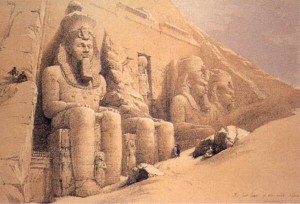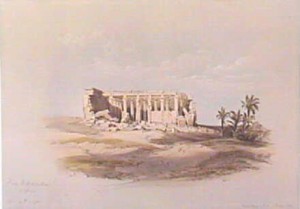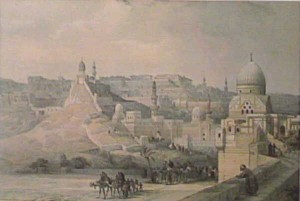As I research Egypt for Book 3 of my ‘Daughters of the Wind’ series I became side tracked looking at the inspiring work of artist David Roberts. He has captured Egypt perfectly, evoking the mystery and intrigue from the era.
David Roberts
Information adapted from Wikipedia, the free encyclopedia www.wikipedia.org
David Roberts RA (24 October 1796 – 25 November 1864) was a Scottish painter. He is especially known for a prolific series of detailed prints of Egypt and the Near East that he produced during the 1840s from sketches he made during long tours of the region (1838–1840). This work, and his large oil paintings of similar subjects, made him a prominent Orientalist painter. He was elected as a Royal Academician in 1841.
 The great Temple of Abu Simbel
The great Temple of Abu Simbel
It was J.M.W. Turner who managed to persuade him to abandon scene painting and devote himself to becoming a true artist. Roberts set sail for Egypt on 31 August 1838, a few years after Owen Jones. His intent was to produce drawings that he could later use as the basis for the paintings and lithographs to sell to the public. Egypt was much in vogue at this time, and travelers, collectors and lovers of antiquities were keen to buy works inspired by the East or depicting the great monuments of ancient Egypt.
The Citadel at Cairo
Roberts made a long tour in Egypt, Nubia, the Sinai, the Holy Land, Jordan and Lebanon. Throughout, he produced a vast collection of drawings and watercolour sketches. Muhammad Ali Pasha received Roberts in Alexandria on 16 May 1839, shortly before his return to Britain. He later reproduced this scene (apparently from memory) in Volume 3 of Egypt & Nubia.
The scenery and monuments of Egypt and Holy Land were fashionable but had hitherto been hardly touched by British artists, and so Roberts quickly accumulated 400 subscription commitments, with Queen Victoria being subscriber #1. Her complete set is still in the Royal Collection.

Wady Maharraka, Nubia
In 1851, and again in 1853, Roberts visited Italy, painting the Ducal Palace, Venice, bought by Lord Londesborough, the Interior of the Basilica of St Peters, Rome, Christmas Day, 1853, and Rome from the Convent of St Onofrio, presented to the Royal Scottish Academy.
His last volume of illustrations, Italy, Classical, Historical and Picturesque, was published in 1859. While the last years of his life were occupied with a series of views of London from the Thames. He had executed six of these, and was at work upon a picture of St Paul’s Cathedral, when he died suddenly of apoplexy.
He was buried at West Norwood Cemetery. His son, David Roberts Jnr, also a watercolour artist, was buried nearby.

Leave a Reply